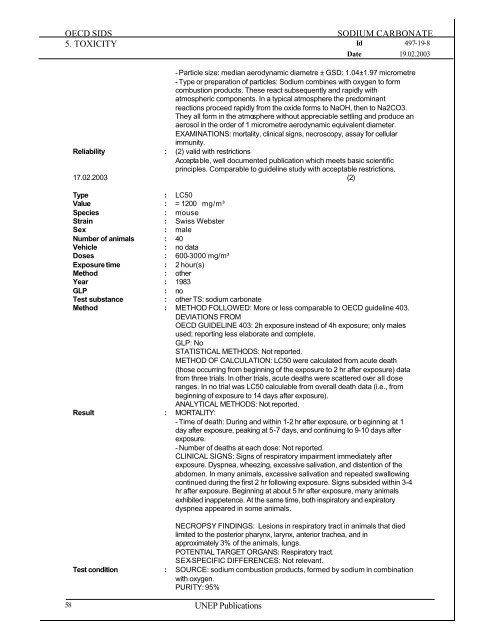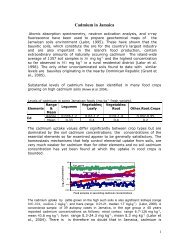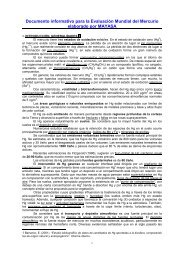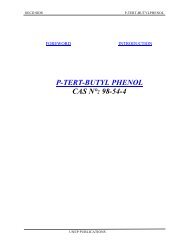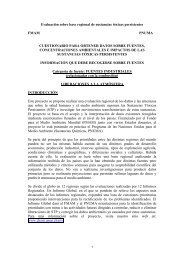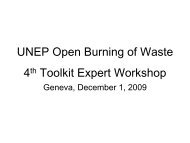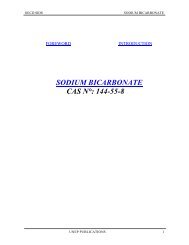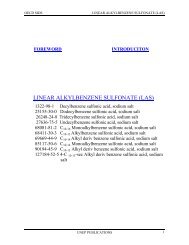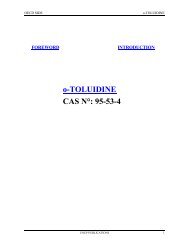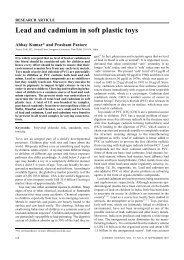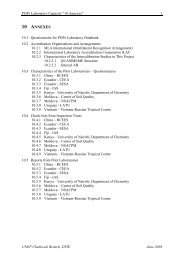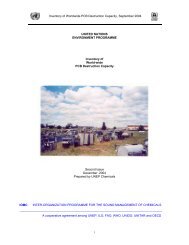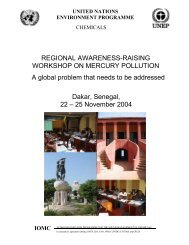SODIUM CARBONATE CAS N°: 497-19-8 - UNEP Chemicals
SODIUM CARBONATE CAS N°: 497-19-8 - UNEP Chemicals
SODIUM CARBONATE CAS N°: 497-19-8 - UNEP Chemicals
You also want an ePaper? Increase the reach of your titles
YUMPU automatically turns print PDFs into web optimized ePapers that Google loves.
OECD SIDS <strong>SODIUM</strong> <strong>CARBONATE</strong><br />
5. TOXICITY Id <strong>497</strong>-<strong>19</strong>-8<br />
Date <strong>19</strong>.02.2003<br />
- Particle size: median aerodynamic diametre ± GSD: 1.04±1.97 micrometre<br />
- Type or preparation of particles: Sodium combines with oxygen to form<br />
combustion products. These react subsequently and rapidly with<br />
atmospheric components. In a typical atmosphere the predominant<br />
reactions proceed rapidly from the oxide forms to NaOH, then to Na2CO3.<br />
They all form in the atmosphere without appreciable settling and produce an<br />
aerosol in the order of 1 micrometre aerodynamic equivalent diameter.<br />
EXAMINATIONS: mortality, clinical signs, necroscopy, assay for cellular<br />
immunity.<br />
Reliability : (2) valid with restrictions<br />
Acceptable, well documented publication which meets basic scientific<br />
principles. Comparable to guideline study with acceptable restrictions.<br />
17.02.2003 (2)<br />
Type : LC50<br />
Value : = 1200 mg/m³<br />
Species : mouse<br />
Strain : Swiss Webster<br />
Sex : male<br />
Number of animals : 40<br />
Vehicle : no data<br />
Doses : 600-3000 mg/m³<br />
Exposure time : 2 hour(s)<br />
Method : other<br />
Year : <strong>19</strong>83<br />
GLP : no<br />
Test substance : other TS: sodium carbonate<br />
Method : METHOD FOLLOWED: More or less comparable to OECD guideline 403.<br />
DEVIATIONS FROM<br />
OECD GUIDELINE 403: 2h exposure instead of 4h exposure; only males<br />
used; reporting less elaborate and complete.<br />
GLP: No<br />
STATISTICAL METHODS: Not reported.<br />
METHOD OF CALCULATION: LC50 were calculated from acute death<br />
(those occurring from beginning of the exposure to 2 hr after exposure) data<br />
from three trials. In other trials, acute deaths were scattered over all dose<br />
ranges. In no trial was LC50 calculable from overall death data (i.e., from<br />
beginning of exposure to 14 days after exposure).<br />
ANALYTICAL METHODS: Not reported.<br />
Result : MORTALITY:<br />
- Time of death: During and within 1-2 hr after exposure, or b eginning at 1<br />
day after exposure, peaking at 5-7 days, and continuing to 9-10 days after<br />
exposure.<br />
- Number of deaths at each dose: Not reported.<br />
CLINICAL SIGNS: Signs of respiratory impairment immediately after<br />
exposure. Dyspnea, wheezing, excessive salivation, and distention of the<br />
abdomen. In many animals, excessive salivation and repeated swallowing<br />
continued during the first 2 hr following exposure. Signs subsided within 3-4<br />
hr after exposure. Beginning at about 5 hr after exposure, many animals<br />
exhibited inappetence. At the same time, both inspiratory and expiratory<br />
dyspnea appeared in some animals.<br />
Test condition<br />
58<br />
:<br />
NECROPSY FINDINGS: Lesions in respiratory tract in animals that died<br />
limited to the posterior pharynx, larynx, anterior trachea, and in<br />
approximately 3% of the animals, lungs.<br />
POTENTIAL TARGET ORGANS: Respiratory tract.<br />
SEX-SPECIFIC DIFFERENCES: Not relevant.<br />
SOURCE: sodium combustion products, formed by sodium in combination<br />
with oxygen.<br />
PURITY: 95%<br />
IMPURITY/ADDITIVE/ETC.: 2.5% NaOH and 2.5% NaHCO3<br />
<strong>UNEP</strong> Publications


